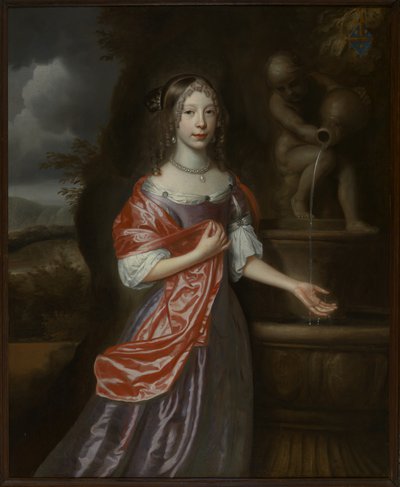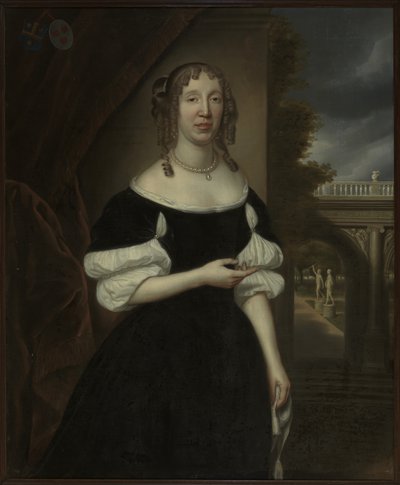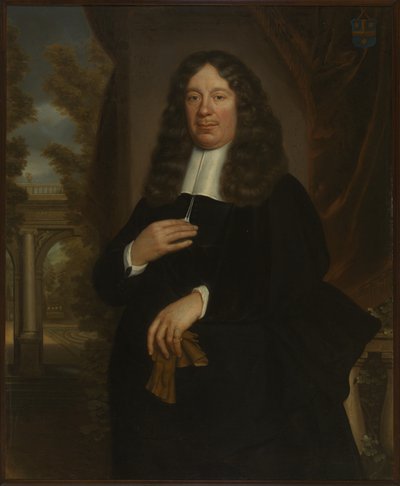Society Portraitist in The Hague
The promise of social advancement (opsteygeren as described in his Introduction) likely motivated Van Hoogstraten to continue pursuing portrait patronage when he returned to his native country in 1667.1 He chose to settle in The Hague, where he could parlay his London experience much better than in provincial Dordrecht. A substantial number of commissions for portraits came in the ensuing years, including one for a recently rediscovered pair in Darmstadt, dated 1670, finely executed but modest in presentation [42][43]. Likely in the same city, Van Hoogstraten received a prestigious commission for a large, three-quarter length portrait of the Admiral and statesman Mattheus van den Broucke (1620-1685) [44]. Here, he applied his wide-ranging ability to depict various subjects, from portraiture to costume to landscape and sea, with considerable control of the brush. The genre of heroic maritime portraiture dictated celebratory bombast, but Van Hoogstraten also includes a bit of himself in this portrait. There is a striking parallel to the demonstrative mastery of various materials and subject matter in Van Hoogstraten’s grand architectural perspectives, which likewise present a feast for the eye. The Van den Broucke portrait is not dated, but very likely originated shortly after the sitter returned home with a merchant fleet from the Indies, holding a cargo of 15 million guilders, on 1 July 1670.2 In his portrait, he proudly wears the golden chain and medallion he was awarded for this service.

44
Samuel van Hoogstraten
Portrait of Mattheus van den Broucke (1620-1685), c. 1670-1678
Amsterdam, Rijksmuseum, inv./cat.nr. SK-A-158

42
Samuel van Hoogstraten
Portrait of an unknown man, dated 1670
Darmstadt, Schlossmuseum Darmstadt, inv./cat.nr. DA B 21200

43
Samuel van Hoogstraten
Portrait of an unknown woman, dated 1670
Darmstadt, Schlossmuseum Darmstadt, inv./cat.nr. DA B 21201
Stylistically, the crisp and solid rendering of Van den Broucke’s face aligns very closely with that of another important portrait commission, of Maarten Pauw, which is dated 1671 [46]. In that same year, Van Hoogstraten also completed another seven portraits of Pauw’s family members - of his wife Elizabeth van der Meer [45] and their six children.3 For the latter, the artist permitted himself greater dynamism in pose and composition, particularly in the portrait of daughter Volkera Pauw [47], its slender elegance showing the impact of Anthony van Dyck (1599-1641), which Van Hoogstraten had picked up in London. Such dynamic effects already surface in an exterior perspective scene painted in 1668, featuring surreally billowing clouds and actively posed sculptures in an otherwise quiet courtyard [48]. They also appear in the Van den Broucke portrait. The clouds and backlit trees could be indebted to the landscapes of Jan Lievens (1607-1674), Rembrandt’s old friend, as seen in his hilly landscape in Rotterdam.

47 Samuel van Hoogstraten, Portrait of Volkera Pauw (1658-1674), dated 1671, Private collection

45 Samuel van Hoogstraten, Portrait of Elisabeth van der Meer (1626-1708), dated 1671, Private collection

46 Samuel van Hoogstraten, Portrait of Maarten Pauw (1616-1680), dated 1671, Private collection
Architecture, landscape, and a billowing sky also provide a stage for a very large and highly ambitious painting now in Finspång, Sweden, signed and dated 1670 [49]. On the right, a prominent full-length nude female figure, the only one in Van Hoogstraten’s painted oeuvre, allegorically presents the theme of the triumph of Truth and Justice, and opposite her are figures of deception and envy. In this scene, Van Hoogstraten is obviously referring to his own art, which is faithful to nature, where ‘honest’ play of deception reveals truth. There is no documentary evidence of a specific patron for this artwork, but with its specific reference to the art of painting, Van Hoogstraten may have been aiming at the Confrèrie Pictura, the fraternity of painters in The Hague, which he had joined in 1668, possibly as decoration for one of its interior spaces.4

48
Samuel van Hoogstraten
View from a villa with statues and a woman at a fountain, dated 1668
Amsterdam, Geneva, art dealer Salomon Lilian Old Master Paintings

49
Samuel van Hoogstraten
Triumph of Truth and Justice, dated 1670
Private collection
Notes
1 On social advancement as a goal for Van Hoogstraten, see Samuel van Hoogstraten, ‘the Ingenious and Poetic Painter’ by Michiel Roscam Abbing in this study.
2 Van der Aa 1852-1878, vol. 2-2, p. 1418.
3 Portrait of Engelbert Pauw, 1671; Portrait of Maria Pauw, 1671; Portrait of Franco Pauw, 1671; Portrait of Volkera Pauw, 1671; Portrait of Jacob Pauw, 1671; Portrait of Isabella Cornelia Pauw, 1671.
4 The Hague Municipal Archives, 0350-01: Oud-archief van 's-Gravenhage 1313-1815; 0164-01: Confrerie Pictura en Tekenacademie; 1.1 Pictura; 10: 'Register der betaalde meestergelden', 1657-1800, dd. 21 januari 1668.

